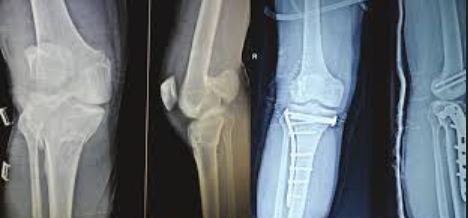Functional Outcome of Operatively Treated Floating Knee Injuries in Adults
Abstract
Background:Floating knee injuries result from high velocity trauma and are associated with high morbidity. There are no clear guidelines for their management. This study evaluated the functional outcomes of operatively treated floating knee injuries in adults and the factors affecting them.
Methods: Thirty patients (29 men, 1 women; mean age30.7 years; range, 15 to 70 years) were included in the study. The fractures were classified according to the classification by Blake and McBrydes.Femur fractures were treated using intramedullary interlocking nails either antegrade or retrograde or locking compression plate and tibia fractures were treated with either external fixator, locking compression plate or intramedullary interlocking nails. Follow up was done at 4 weeks, 8 weeks, 6 months and 1 year.
Results: The functional outcome was accessed using Karlstrom And Olerued Criteria and was: Excellent in 3, Good in 9, Acceptable in 10 and Poor in 8 patients.
Conclusion:The factors which determine the functional outcomes were type of fracture (open or closed), pattern and site of fracture, presence of intra articular extension and method of fixation used. The best management of these injuries involves intramedullary nailing of both the fractures.
Downloads
References
Veith RG, Winquist RA, Hansen ST Jr. Ipsilateral fractures of the femur and tibia. A report of fifty-seven consecutive cases. J Bone Joint Surg Am 1984 Sep;66(7):991-1002
Blake R, McBryde A Jr . The floating knee: Ipsilateral fractures of the tibia and femur.South Med J 1975 Jan;68(1):13-6.
Gustilo RB, Anderson JT. Prevention of infection in the treatment of one thousand and twenty-five open fractures of long bones: retrospective and
prospective analyses. J Bone Joint Surg Am 1976 Jun;58(4):453-58.
Karlstrom G, Olerud S . Ipsilateral fracture of the femur and tibia. J Bone Joint Surg Am 1977 Mar;59(2):240-43.
Hayes JT: Multiple fractures in same extremity: Some problems in their management. Surgical Clinics of North America 1961;41:1379-88.
Fraser RD, Hunter GA, Waddell JP. Ipsilateral fracture of the femur and tibia. J Bone Joint Surg Br 1978 Nov;60-B(4):510-15.
Adamson GJ, Wiss DA, Lowery GL, Peters CL. Type II floating knee: ipsilateral femoral and tibial fractures with intraarticular extension into the knee joint. J Orthop Trauma 1992;6(3):333-39.
Hee HT, Wong HP, Low YP, Myers L. Predictors of outcome of floating knee injuries in adults: 89 patients followed for 2-12 years. Acta OrthopScand 2001 Aug;72(4):385-94.
Bansal VP, Singhal V, Mam MK, Gill SS The floating knee. 40 cases of ipsilateral fractures of the femur and the tibia. IntOrthop 1984;8(3):183-87.
Ul-Haque I. A floating knee treated conservatively: a case report. Injury 1983May;14(6):554-57.
Katada S, Ando K, Nakagawa K, Yamada T, Sasamoto H, Kawabe N et al. Floating knee fracture (ipsilateral fracture of the femur and tibia)--treatment by closed Ender nailing. Nippon Seikeigeka Gakkai Zasshi 1984 May;58(5):475-83.
Behr JT, Apel DM, Pinzur MS, Dobozi WR, Behr MJ . Flexible intramedullary nails for ipsilateral femoral and tibial fractures. J Trauma 1987 Dec;27(12):1354-
Lobenhoffer P, Krettek C, Tscherne H. Complex knee joint trauma Orthopade. 1997 Dec;26(12):1037-45.
Rethnam U . Single incision nailing of the floating knee-do we ignore the knee ligaments?. IntOrthop 2006 Aug;30(4):311.
Dwyer AJ, Paul R, Mam MK, Kumar A, Gosselin RA. Floating knee injuries: long-term results of four treatment methods. IntOrthop 2005 Oct; 29(5):314-18
Gregory P, DiCicco J, Karpik K, DiPasquale T, Herscovici D, Sanders R . Ipsilateral fractures of the femur and tibia: treatment with retrograde femoral nailing and unreamed tibial nailing. J Orthop Trauma 1996;10(5):309-16.
Schiedts D, Mukisi M, Bouger D, Bastaraud H . Ipsilateral fractures of the femoral and tibial diaphyses. Rev ChirOrthopReparatriceAppar Mot 1996; 82(6):535-40.
Kumar A, Mam MK, Paul R. Ipsilateral fracture of femur and tibia, treatment and functional outcome. J K Science: Journal of Medical Education and Research 2006;8 (1):42-44.

The entire contents of the Orthopaedic Journal of Madhya Pradesh Chapter are protected under Indian and International copyrights. Orthopaedic Journal of Madhya Pradesh Chapter allow authors to retain the copyrights of their papers without restrictions, Authors grant the publisher the right of exclusive publication. The Journal then grants to all users a free, irrevocable, worldwide, perpetual right of access to, and a license to copy, use, distribute, perform and display the work publicly and to make and distribute derivative works in any digital medium for any reasonable non-commercial purpose, subject to proper attribution of authorship. The journal also grants the right to make numbers of printed copies for their personal non-commercial use under Creative Commons Attribution-Non-commercial share alike 4.0 International Public License.

 OAI - Open Archives Initiative
OAI - Open Archives Initiative












